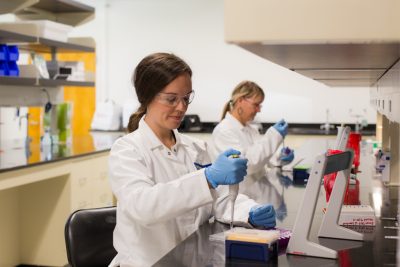Background: Best practice standards for measuring analyte levels in saliva recommend that all biospecimens be tested in replicate with mean concentrations used in statistical analyses. This approach prioritizes minimizing laboratory-based measurement error but, in the process, expends considerable resources. We explore the possibility that, due to advances in salivary assay precision, the contribution of laboratory-based measurement error in salivary analyte data is very small relative to more important and meaningful variability in analyte levels across biological replicates (i.e., between different specimens). To evaluate this possibility, we examine the utility of the repeatability intra-class correlation (rICC) as an additional index of salivary analyte data precision. Using randomly selected subsamples (Ns=200 and 60) of salivary analyte data collected as part of a larger epidemiologic study, we compute the rICCs for seven commonly assayed salivary measures in biobehavioral research – cortisol, alpha-amylase, c-reactive protein, interlekin-6, uric acid, secretory immunoglobulin A, and testosterone. We assess the sensitivity of rICC estimates to assay type and the unique distributions of the underlying analyte data. We also use simulations to examine the bias, precision, and coverage probability of rICC estimates calculated for small to large sample sizes. For each analyte, the rICCs revealed that less than 5% of variation in analyte levels was attributable to laboratory-based measurement error. rICC estimates were similar across all analytes despite differences in analyte levels, average intra-assay coefficients of variation, and in the distributional properties of the data. Guidelines for calculating rICC are provided to enable investigators and laboratory staff to apply this metric and more accurately quantify, and communicate, the magnitude of laboratory-based measurement error in their data. By helping investigators scale measurement error relative to more scientifically meaningful variability between biological replicates, the application of the rICC has the potential to influence research strategies and tactics such that resources (e.g., finances, effort, number/volume of biospecimens) are allocated more efficiently and effectively.
Diurnal Salivary Alpha-Amylase Dynamics Among Dementia Family Caregivers.
Background:
Objective: The study examined diurnal regulation of salivary alpha-amylase (sAA) in association with daily stressors, adult day services (ADS) use, and other caregiving characteristics. Method: A sample of 165 family caregivers of individuals with dementia (IWD) completed an 8-day diary study. Caregivers provided 5 saliva samples across the 8 days. On some days, caregivers provided all or most of the care. On other days, their relative attended ADS for part of the day. A 3-level unconditional linear spline model was fit to describe the typical sAA diurnal rhythms. Predictors were then added to the unconditional model to test the hypotheses on ADS use and daily stressors. Results: Daily ADS use did not have an effect on diurnal sAA regulation. However, controlling for daily ADS use, greater ADS use over the 8 days was associated with a more prominent rise between 30 min after wake-up and before lunch, and a more prominent decline between before lunch and late afternoon. Fewer ADS days were associated with a more flattened sAA diurnal rhythm. Additionally, greater daily care-related stressor exposures had a within-person association with lower sAA levels in the late afternoon. Care-related stressor exposures had significant within- and between-person associations with sAA diurnal slopes. Furthermore, daily positive experiences had a significant between-person association with sAA diurnal slopes. Conclusions: Caring for a disabled family member may heighten the vulnerability to potential physiological conditions. Respite from care stressors from ADS use may have some biobehavioral benefits on sAA regulations.
Coordination of cortisol response to social evaluative threat with autonomic and inflammatory responses is moderated by stress appraisals and affect.
Background: Recent approaches to stress regulation have emphasized coordination among multiple biological systems. This study builds on evidence that hypothalamic-pituitary-adrenal (HPA) axis activity should be considered in coordination with other stress-sensitive biological systems to characterize healthy responses. Healthy African-Americans (n=115) completed the Trier Social Stress Test, and biological responses were assessed through salivary cortisol, dehydroepiandrosterone-sulfate (DHEA-S), alpha amylase (sAA), and C-reactive protein (sCRP). Multilevel modeling demonstrated that cortisol responses typically aligned with changes in DHEA-S, sAA, and sCRP across the session. At the same time, the degree of cortisol coordination with sAA and sCRP varied by participants’ subjective stress following the task; participants with higher secondary stress appraisals showed greater cortisol-sAA alignment, whereas those experiencing more negative affect showed greater cortisol-sCRP alignment. Results highlight the importance of a multisystem approach to stress and suggest that positive HPA axis coordination with the autonomic response, but not with the immune/inflammatory response, may be adaptive.
Coordination of cortisol response to social evaluative threat with autonomic and inflammatory responses is moderated by stress appraisals and affect.
Background: Recent approaches to stress regulation have emphasized coordination among multiple biological systems. This study builds on evidence that hypothalamic-pituitary-adrenal (HPA) axis activity should be considered in coordination with other stress-sensitive biological systems to characterize healthy responses. Healthy African-Americans (n=115) completed the Trier Social Stress Test, and biological responses were assessed through salivary cortisol, dehydroepiandrosterone-sulfate (DHEA-S), alpha amylase (sAA), and C-reactive protein (sCRP). Multilevel modeling demonstrated that cortisol responses typically aligned with changes in DHEA-S, sAA, and sCRP across the session. At the same time, the degree of cortisol coordination with sAA and sCRP varied by participants’ subjective stress following the task; participants with higher secondary stress appraisals showed greater cortisol-sAA alignment, whereas those experiencing more negative affect showed greater cortisol-sCRP alignment. Results highlight the importance of a multisystem approach to stress and suggest that positive HPA axis coordination with the autonomic response, but not with the immune/inflammatory response, may be adaptive.

